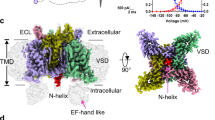Abstract
Excitation of nerve or muscle requires an orderly opening and closing of molecular pores, the ionic channels, in the plasma membrane. During the action potential, Na channels are opened (activated) by the advancing wave of depolarisation, contributing a pulse of inward sodium current, and then are closed again (inactivated) by the continued depolarisation1. As one approach both to obtaining molecular information on the Na channel and towards further defining the recently discovered kinetic interactions of the inactivation and activation gating steps2–4, we have surveyed here the effects of chemical agents reported to slow or prevent Na channel inactivation. We find that many of the agents studied by others5–14 on invertebrate giant axons or vertebrate nerve act on our frog skeletal muscle preparation. In addition, we have discovered that simply lowering the intracellular pH nearly eliminates inactivation. The activation mechanism seems to resist modification.
Similar content being viewed by others
References
Hodgkin, A. L. & Huxley, A. F. J. Physiol., Lond. 116, 497–506 (1952).
Bezanilla, F. & Armstrong, C. M. J. gen. Physiol. 70, 549–566 (1977).
Armstrong, C. M. & Bezanilla, F. J. gen. Physiol. 70, 567–590 (1977).
Nonner, W. J. Physiol., Lond. 299 (in the press).
Stämpfli, R. Experimentia 30, 505–508 (1974).
Conti, F., Hille, B., Neumcke, B., Nonner, W. & Stämpfli, R. J. Physiol., Lond. 262, 729–742 (1976).
Oxford, G. S., Wu, C. H. & Narahashi, T. J. gen. Physiol. 71, 227–247 (1978).
Shrager, P. G., Strickholm, A. & Macey, R. I. J. cell. Physiol. 74, 91–99 (1969).
Keana, J. F. W. & Stämpfli, R. Biochim. biophys. Acta 373, 18–33 (1974).
Eaton, D. C. & Brodwick, M. S. Biophys. J. 25, 305a (1979).
Eaton, D. C., Oxford, G. S. & Rudy, B. Nature 271, 473–475 (1978).
Shrager, P. G., Macey, R. I. & Strickholm, A. J. cell. Physiol. 74, 77–90 (1969).
Oxford, G. S. & Pooler, J. P. J. gen. Physiol. 66, 765–779 (1975).
Brodwick, M. S. & Eaton, D. C. Science 200, 1494–1496 (1978).
Hille, B. & Campbell, D. T. J. gen. Physiol. 67, 265–293 (1976).
Steinacker, A. Nature 278, 358–360 (1979).
Campbell, D. T. & Hille, B. J. gen. Physiol. 67, 309–323 (1976).
Rojas, E. & Rudy, B. J. Physiol., Lond. 262, 501–531 (1976).
Armstrong, C. M., Bezanilla, F. & Rojas, E. J. gen. Physiol. 62, 375–391 (1973).
Goldman, D. E. J. gen. Physiol. 27, 37–60 (1943).
Author information
Authors and Affiliations
Rights and permissions
About this article
Cite this article
Nonner, W., Spalding, B. & Hille, B. Low intracellular pH and chemical agents slow inactivation gating in sodium channels of muscle. Nature 284, 360–363 (1980). https://doi.org/10.1038/284360a0
Received:
Accepted:
Issue Date:
DOI: https://doi.org/10.1038/284360a0
- Springer Nature Limited
This article is cited by
-
Modification of Na channel inactivation by ?-chymotrypsin in single cardiac myocytes
Pfl�gers Archiv European Journal of Physiology (1990)
-
Gating in iodate-modified single cardiac Na+ channels
The Journal of Membrane Biology (1989)
-
The nonselective cation channel in the basolateral membrane of rat exocrine pancreas
Pflügers Archiv - European Journal of Physiology (1989)
-
Effects of glutaraldehyde on sodium channel activation and inactivation in frog nerve fiber
Neurophysiology (1987)





